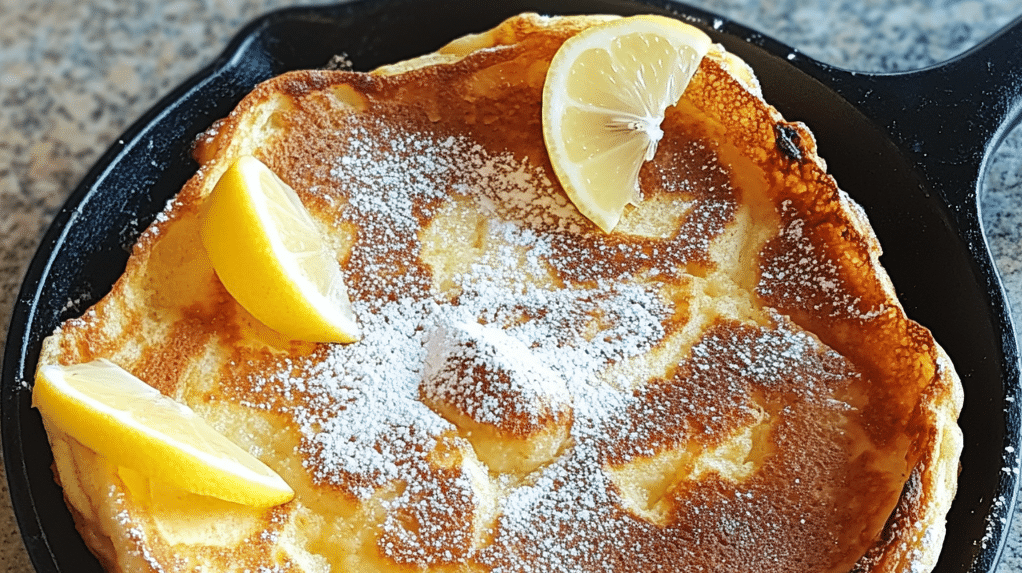Dutch Baby Pancake: The Easiest Baked Brunch You’ll Ever Make
🥞 Dutch Baby Pancake: The Easiest Baked Brunch You’ll Ever Make
🕰️ A Short History of the Dutch Baby Pancake
📜 Origins and Cultural Significance
The story of the Dutch Baby Pancake begins not in the Netherlands, as one might think, but in early 20th century Seattle. A small family-run establishment called Manca’s Café is credited with crafting the very first version of this now-famous oven pancake. Inspired by German-style pancakes and American popovers, the owner’s daughter is said to have coined the name “Dutch Baby”—a misinterpretation of “Deutsch,” the German word for German.
Traditionally, this dish combines the structure of a Yorkshire pudding with the sweetness and comfort of a pancake. It quickly caught on within German-American communities, becoming a weekend staple and a way to bring a taste of Europe to American brunch tables. Over time, the term “Bismarck pancake” also emerged, giving it another nod to its German roots.
🌍 Top 10 Countries That Love Dutch Baby Pancakes
Despite its Seattle origin, the Dutch Baby has traveled across borders and continents. Here’s a look at where it’s most beloved:
- 🇺🇸 United States
- 🇩🇪 Germany
- 🇨🇦 Canada
- 🇳🇱 Netherlands
- 🇬🇧 United Kingdom
- 🇦🇺 Australia
- 🇳🇿 New Zealand
- 🇿🇦 South Africa
- 🇦🇹 Austria
- 🇨🇭 Switzerland
Each of these countries enjoys its own variation, whether it’s filled with spiced apples in Germany or drizzled with maple syrup in Canada. Today, I see the Dutch Baby Pancake as a blank canvas—ideal for both sweet and savory creations, and absolutely perfect for anyone craving an easy yet show-stopping brunch recipe.
For more on cooking with skillets, check out my post on Sweet Potato Breakfast Hash, where I also explore how a cast-iron skillet enhances texture and taste!
Print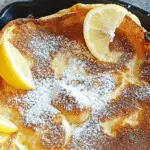
9 Reasons Why This Dutch Baby Pancake Recipe Will Be Your New Brunch Obsession
- Total Time: 25 minutes
- Yield: 2–4 servings 1x
- Diet: Vegetarian
Description
Discover the fluffiest Dutch Baby Pancake recipe ever—crispy edges, custardy center, and ready in under 30 minutes for the perfect weekend treat.
Ingredients
- 3 large eggs
- ½ cup all-purpose flour
- ½ cup whole milk
- ⅛ teaspoon kosher salt
- 2 tablespoons unsalted butter
- Optional: powdered sugar, fresh lemon juice, berries
Instructions
- Preheat oven to 425°F.
- Blend eggs, flour, milk, and salt until smooth.
- Heat butter in cast-iron skillet until bubbling.
- Pour batter into hot skillet.
- Bake for 20 minutes until puffed and golden.
- Serve immediately with toppings of choice.
Cooking Tips for the Perfect Dutch Baby
- Don’t open the oven while baking.
- Ensure skillet is very hot before adding batter.
- Batter should be lump-free.
- Prep Time: 5 minutes
- Cook Time: 20 minutes
- Category: Breakfast
- Method: Baked
- Cuisine: American-German Fusion
🛠️ What You’ll Need
🍳 Essential Equipment
When it comes to making the perfect Dutch Baby Pancake, the right equipment is almost as important as the batter itself. This dramatic, puffed beauty depends on consistent heat, quick mixing, and a seamless transfer from oven to table—something only the right tools can guarantee.
The star of the show is a 10- or 12-inch cast-iron skillet. Its even heat distribution and natural heat retention ensure that signature golden crust and the impressive rise around the edges. Without it, you risk uneven cooking, pale edges, or a soggy center. If you don’t yet own one, investing in a quality skillet will pay off for years—it’s not just for Dutch Babies but for countless savory and sweet recipes.
You’ll also need a mixing bowl and either a whisk or blender. While a whisk works perfectly fine, I personally favor a blender—it whips air into the batter, producing a silky smooth consistency and helping the pancake puff to its fullest potential. That aeration is what makes the difference between a flat pancake and one that rises dramatically in the oven.
Finally, a cooling rack is invaluable for preventing the bottom from steaming once it’s out of the oven, keeping your crust crisp. And don’t forget a rubber spatula for easy, mess-free slicing and serving.
🍽️ Best Tools for the Job
Now let’s get a little more specific. For my Dutch Baby Pancake, I always reach for my Lodge cast-iron skillet—it’s durable, holds heat beautifully, and develops that irresistible, slightly crisp edge every time. Before baking, I preheat my oven to 425°F and use an oven thermometer to make sure it’s at the correct temperature—because an oven that’s underheated can ruin your rise.
If you really want to perfect your cast-iron cooking skills, it’s worth keeping your skillet well-seasoned. This creates a naturally nonstick surface, makes cleanup easier, and enhances the flavor of whatever you cook.
Using reliable, well-maintained tools isn’t just about convenience—it’s about results. The combination of even heat, proper aeration, and a nonstick surface will give you the fluffy center, crisp edges, and beautiful golden color that make Dutch Baby Pancakes so memorable.
For more cast-iron inspiration, check out my Sweet Potato Breakfast Hash, where I share how a well-seasoned skillet transforms texture and builds deep, savory flavor.
🧂 Ingredients
📋 Ingredient List (Based on Competitor Recipe)
Creating a classic Dutch Baby Pancake requires just a handful of pantry staples—but using them correctly makes all the difference. Here’s what I always use:
- 3 large eggs (room temperature)
- ½ cup all-purpose flour
- ½ cup whole milk (room temperature)
- ⅛ teaspoon kosher salt
- 2 tablespoons unsalted butter (for the skillet)
- Optional toppings: powdered sugar, fresh lemon juice, seasonal berries
This base creates the signature puff and custardy center that defines a Dutch Baby, also known as a baked pancake or popover pancake.
🧠 Tips for Ingredient Quality
Let me be clear—ingredient quality transforms this recipe. Using room-temperature eggs and milk ensures better emulsification, which leads to more lift in the oven. Cold ingredients, on the other hand, can inhibit that iconic rise.
When it comes to flour, I find that organic all-purpose flour provides a cleaner taste and lighter texture. As for butter, go unsalted—it allows for better control of flavor and highlights the lemony finish if you choose to garnish.
Freshly squeezed lemon juice brightens each bite, balancing out the richness of the egg and butter. Powdered sugar adds that final touch of indulgence, creating a brunch dish that’s both rustic and elegant.
Curious about how eggs influence texture in baked breakfasts? I share detailed insights in my Spinach and Mushroom Quiche, where egg quality makes all the difference!
👨🍳 Instructions
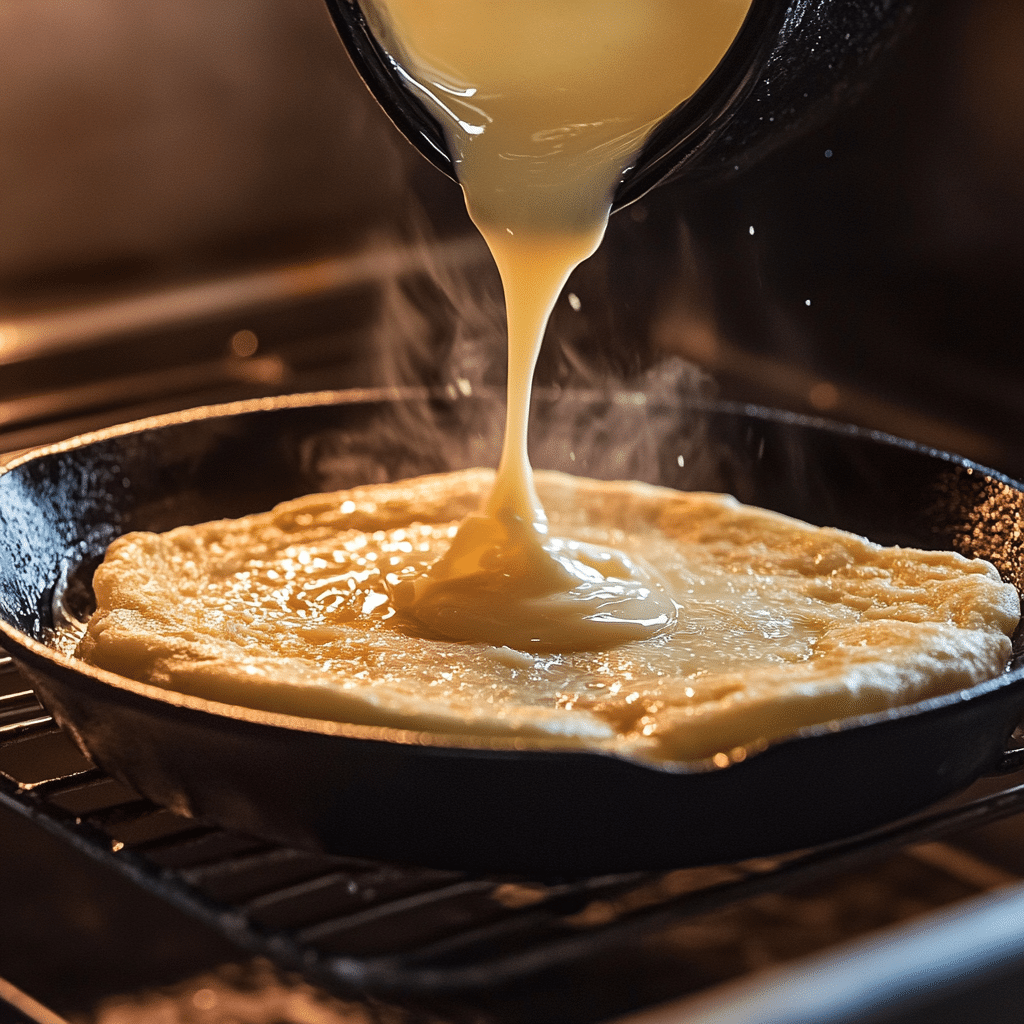
🔥 Step-by-Step Cooking Directions
Making a Dutch Baby Pancake is easier than it looks, and the dramatic puff always impresses. Follow these steps for picture-perfect results every time:
- Preheat your oven to 425°F. Place your 10- or 12-inch cast-iron skillet inside while the oven heats. A scorching hot pan is crucial for that signature puff.
- Blend the batter. In a blender, combine 3 large eggs, ½ cup all-purpose flour, ½ cup whole milk, and ⅛ teaspoon kosher salt. Blend until completely smooth—about 20 seconds. This ensures no lumps and maximum air incorporation.
- Melt butter. When the oven is fully preheated, take the skillet out with care and drop in 2 tablespoons of unsalted butter.
- Add batter. Gently transfer the smooth batter into the hot, butter-greased skillet, then return it right away to the oven to bake until beautifully golden and puffed.
- Bake for 20 minutes. Do not open the oven door during baking! This allows steam to work its magic, inflating your popover pancake into a golden masterpiece.
- Serve fresh. Once puffed and deeply golden, remove from oven. Add toppings like powdered sugar, lemon juice, or berries and serve right away.
🍽️ Cooking Tips for the Perfect Dutch Baby
There are three golden rules I stick to when baking this cast-iron pancake. First, never open the oven door mid-bake—it’ll collapse like a soufflé. Second, always preheat the skillet to get that crispy bottom. Third, make sure your batter is lump-free to avoid dense spots.
The beauty of this baked pancake recipe is how effortlessly it transitions from breakfast to brunch centerpiece. Once you get the hang of the timing and temperature, you’ll want to make it weekly.
🧾 Prep & Cook Time
⏱️ Quick Overview
One of the reasons I love this Dutch Baby Pancake so much is how little time it takes to whip up something that looks (and tastes) fancy.
- Prep Time: 5 minutes
- Cook Time: 20 minutes
- Total Time: 25 minutes
- Yield: Serves 2–4 depending on toppings and sides
I recommend prepping your toppings while the pancake bakes, so it’s ready to enjoy fresh out of the oven. Because this oven pancake deflates quickly after baking, it’s best eaten immediately.
🧮 Nutrition Score
📊 Estimated Nutrition per Serving (½ Pancake)
This easy brunch recipe is light, satisfying, and adaptable based on toppings:
- Calories: 310
- Fat: 15 oz
- Protein: 10 oz
- Carbohydrates: 30 oz
- Sugar: 8 oz
- Sodium: 220 mg
These numbers can vary depending on your toppings. Adding whipped cream, fresh fruit, or a drizzle of maple syrup will naturally increase the sugar and calorie count. For a savory twist with cheese or ham, expect higher sodium and fat content.
This recipe is vegetarian-friendly and filling without being too heavy. If you’re watching your intake, topping it with fresh fruit and skipping added sugar makes for a wholesome, energy-boosting start to your day.
🍽️ Serving & Storage Tips
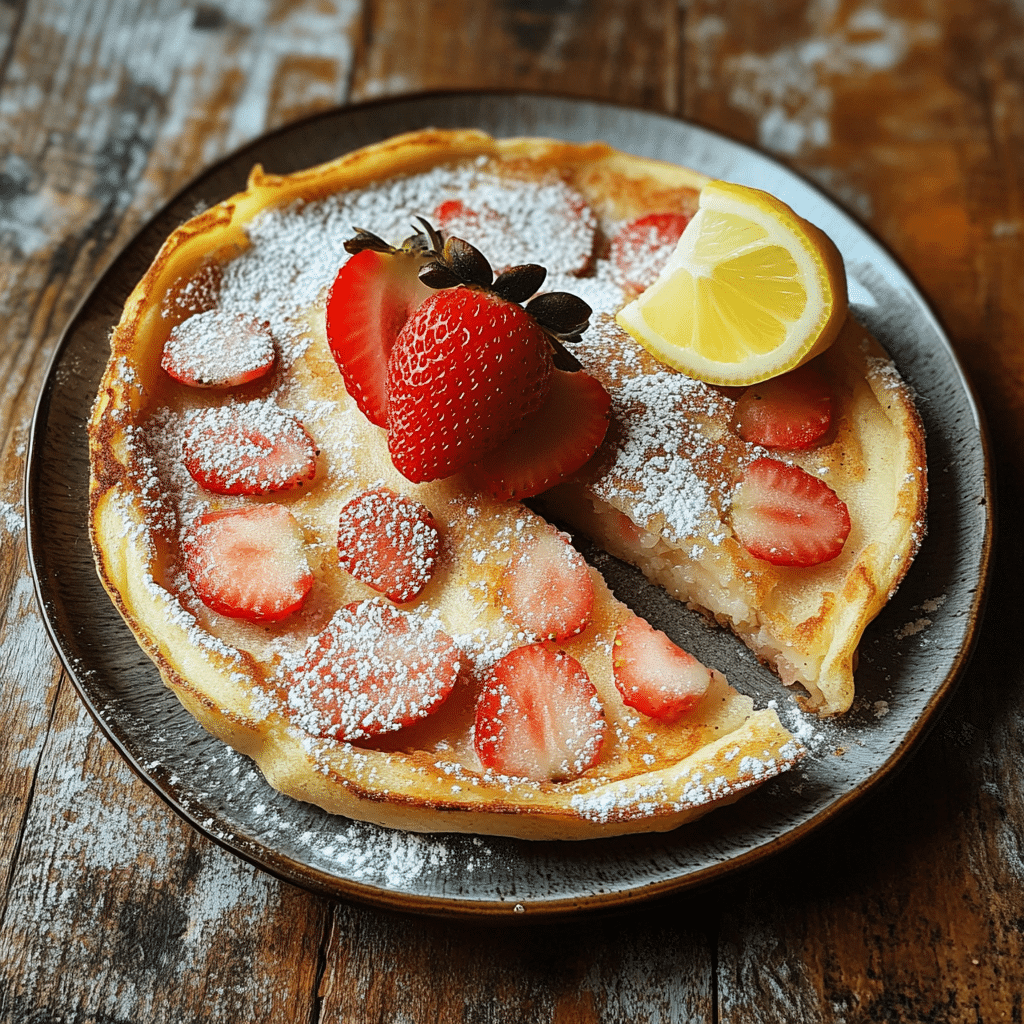
🍓 Serving Suggestions
The beauty of a Dutch Baby Pancake is how easily it transforms into whatever your appetite craves—sweet indulgence or savory sophistication. Right out of the oven, it’s at its peak: puffed dramatically, edges crisped to perfection, and the center warm and custardy. I often dust it with a snowy layer of powdered sugar, squeeze over a hint of bright lemon juice, and finish with a handful of seasonal fruit—think juicy summer berries, tender poached pears, or even caramelized apples in the fall. Finish with a dollop of lightly sweetened whipped cream or a drizzle of warm maple syrup for a brunch-worthy, photo-ready touch.
When hearty, savory flavors call to you, the Dutch Baby becomes the ultimate base for crafting endless flavorful creations. Sprinkle freshly grated Gruyère or sharp cheddar over the hot pancake so it melts luxuriously into the surface, then top with fresh herbs, crispy bacon, or smoked salmon for a flavor profile that feels straight out of a café menu. The versatility means you can make it a family-friendly treat in the morning and a dinner-party appetizer in the evening.
For more creative topping inspiration, take a peek at my Pineapple Upside Down Pancakes. You’ll see how playful combinations of fruit, texture, and presentation can turn a simple base into a true showstopper.
🎨 Variations
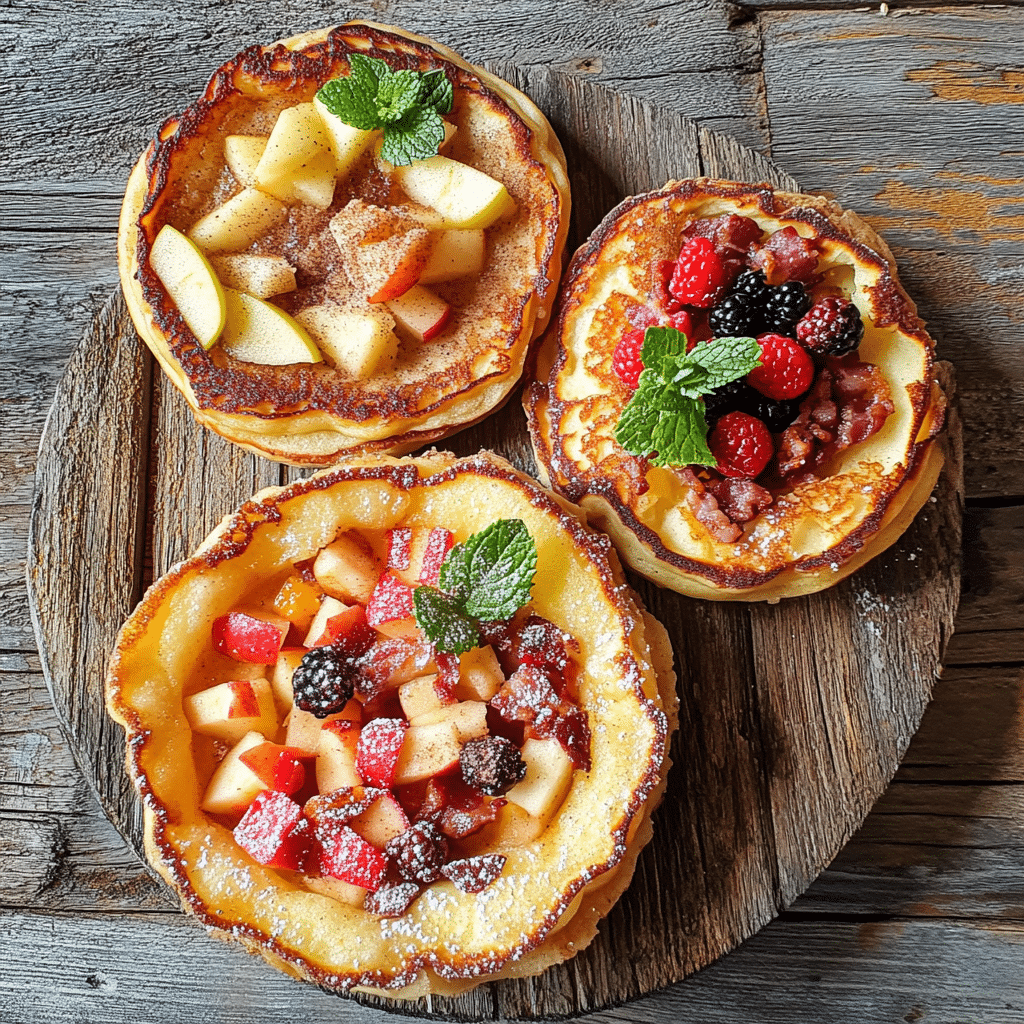
🧁 Sweet Variations
Dutch Baby Pancakes are endlessly customizable, especially for those with a sweet tooth. Here are my favorite indulgent twists:
- Apple-Cinnamon Dutch Baby: Add thin apple slices sautéed in cinnamon and brown sugar before baking. The apples caramelize, turning this into a warm, fall-inspired treat.
- Chocolate Chip Dutch Baby: Mix semi-sweet chips into the batter or sprinkle on top after baking. Perfect for kids—or anyone needing a cocoa fix.
- Vanilla Bean and Pear Dutch Baby: Add a touch of vanilla extract to the batter and layer in slices of ripe pear. It’s elegant enough for holiday mornings.
These sweet spins elevate this simple German pancake recipe into a standout brunch item that guests will rave about.
🧄 Savory Variations
Going savory? Here are some options that never miss:
- Bacon and Cheddar Dutch Baby: Add crumbled bacon and shredded cheddar either inside the batter or as toppings. A must for breakfast lovers who lean salty.
- Spinach and Feta Dutch Baby: A Greek-inspired twist with crumbled feta and sautéed spinach.
- Herbed Mushroom Dutch Baby: Sauté mushrooms with garlic and thyme, then spoon onto the baked pancake. Earthy and satisfying.
For another hearty skillet idea, check out my Sweet Potato Breakfast Hash, where crisp edges and warm spices shine—similar to these savory variations.
🌾 Gluten-Free or Dairy-Free Swaps
I often make this recipe with dietary swaps for friends and family:
- Gluten-Free: Replace the all-purpose flour with a 1:1 GF blend.
- Dairy-Free: Use almond milk and melt coconut oil in place of butter.
These alternatives still yield a deliciously puffed result, just with a twist that suits your needs.
❓ Frequently Asked Questions
🤔 What is the difference between a Dutch Baby and a pancake?
A Dutch Baby Pancake is baked in a skillet and puffs dramatically in the oven, creating crispy edges and a custardy center. In contrast, regular pancakes are cooked on a griddle and stay flat. Dutch Babies resemble popovers more than flapjacks—they’re dramatic, eggy, and best served immediately after baking.
This dish is also known as a popover pancake, oven pancake, or Bismarck pancake, depending on where you’re from. The magic lies in the steam—no baking powder or soda required.
🤔 What is a Dutch Baby Pancake made of?
It’s a simple combination: eggs, flour, milk, salt, and butter. Once baked in a preheated cast-iron skillet, the batter rises rapidly and forms a golden, airy shell. Most people enjoy it with powdered sugar, lemon juice, or fresh berries, but it’s versatile enough to pair with savory flavors too.
The best part? There are no fancy ingredients or techniques needed. If you’ve got a blender and a hot oven, you’re halfway there.
🤔 What makes Dutch pancakes different?
Dutch pancakes (or German pancakes) rely on steam for their rise, not leavening agents. That’s why the batter must be lump-free and your skillet blazing hot. The result is a puffy pancake with crispy sides and a soft, almost custard-like middle—perfect for brunch or a light dessert.
🤔 How to eat a Dutch Baby Pancake?
I recommend tearing it like a crepe or cutting it pizza-style. Dip it into lemon juice and powdered sugar or top it with fruit and maple syrup. Since it’s made in one pan, there’s no flipping or stacking—just slice and serve.
✅ Conclusion: Why You’ll Fall in Love with This Dutch Baby Pancake Recipe
When I think of a breakfast that feels special yet asks so little of me in the kitchen, this Dutch Baby Pancake always comes to mind. There’s just something magical about watching it puff up in the oven, its golden edges curling dramatically over a tender, custardy center. The texture is a perfect balance—light and airy on the outside, soft and almost crêpe-like in the middle—ready to carry whatever toppings your heart desires.
It’s the ultimate weekend showstopper without the fuss. No standing over the stove flipping batch after batch; just a quick whisk, a preheated skillet, and the oven does the rest. In less than half an hour, I can have a stunning centerpiece for the table that makes guests think I’ve gone full gourmet chef.
What I love most is its versatility — dress it up with a drizzle of maple syrup and a sprinkle of powdered sugar for a classic feel, keep it fresh with berries and whipped cream, or take it savory with smoked salmon, fragrant herbs, and a dollop of crème fraîche. Kids adore it, adults can’t get enough of it, and it works as effortlessly for a quiet morning alone as it does for a lively brunch with friends.
If this recipe wins you over like it has for me, you might also enjoy other skillet-made delights. My Sweet Potato Breakfast Hash brings earthy sweetness and a satisfying crunch, while the Pineapple Upside Down Pancakes add a tropical, caramelized twist to your morning. Both deliver big flavor with simple, accessible ingredients—the kind of cooking that feels good, tastes incredible, and makes every meal just a little more memorable.

